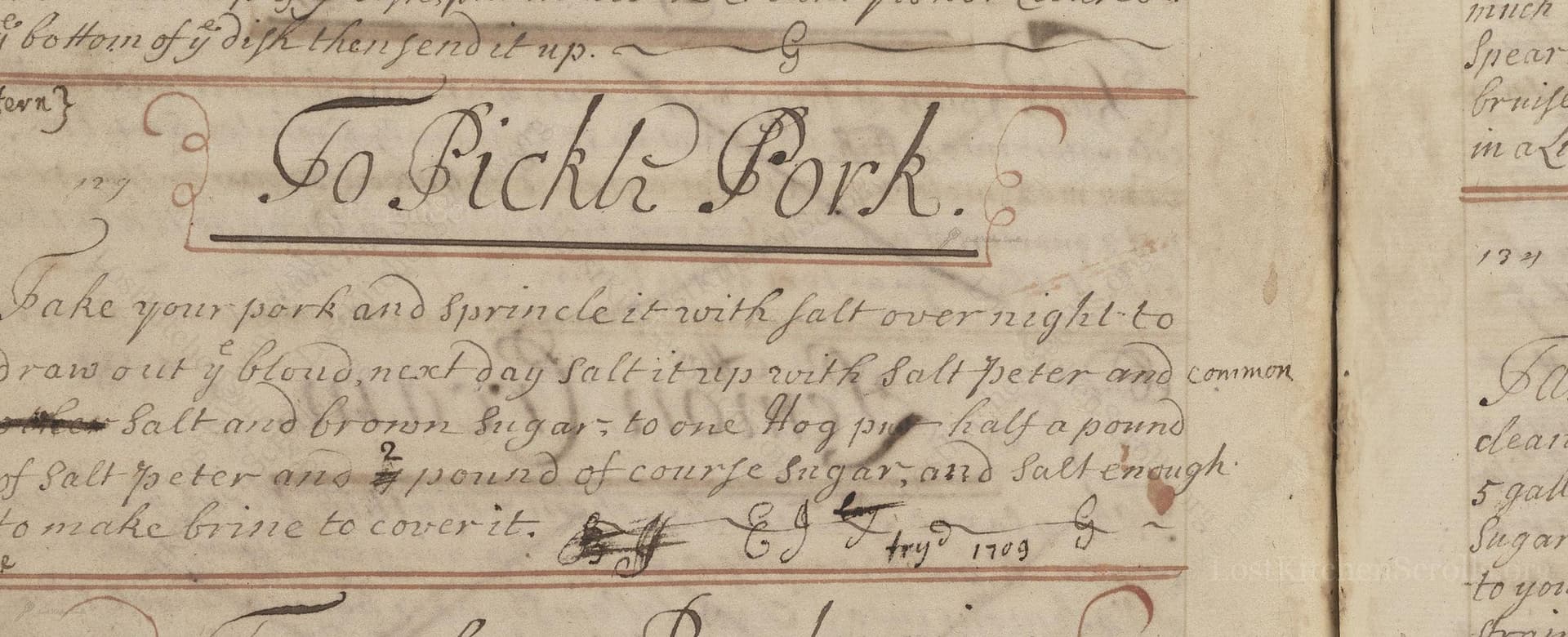To Pickle Pork
From the treasured pages of English cookery and medicine book,
Unknown Author

To Pickle Pork
"Take your pork and sprinkle it with salt over night to keep all & draw out ye bloud, next Day Salt it up with Salt peter and common sugar; to one Hog put half a pound of Salt peter and 2 pounds of course sugar, and Salt enough to make brine to cover it. tryd 1709"
Note on the Original Text
The recipe is written in the succinct style of early 18th-century English manuscripts—assuming substantial knowledge on the part of the reader. Spelling is inconsistent ('bloud' for 'blood', 'tryd' for 'tried'), reflecting non-standardized English of the time. Instructions are delivered sequentially, without precise times or measurements by today’s standards. Ingredients such as 'Salt peter' (potassium nitrate) are used for both preservation and color retention, though modern cooks should use less for safety. The meaning of 'Salt enough to make brine' reflects an experiential approach—knowing the proper 'feel' for curing mixtures was part of the cook’s skill.

Title
English cookery and medicine book, (1694)
You can also click the book image above to peruse the original tome
Writer
Unknown
Era
1694
Publisher
Unknown
Background
A delightful journey through late 17th to early 18th-century kitchens, this tome features recipes, culinary wisdom, and mouthwatering secrets from an era where feasts reigned supreme and the art of cooking was celebrated with flourish.
Kindly made available by
Folger Shakespeare Library
This recipe is taken from an English household manuscript dating roughly between 1677 and 1711. During this period, home preservation of meat was essential, as there was no refrigeration, and making salt pork was a key way to ensure a supply of meat through winter. The use of both saltpetre and sugar reflects both preservation needs and the gradual introduction of new ingredients like sugar into common cookery as trade expanded. The recipe, 'To Pickle Pork', was likely written by or for a household cook, aiming to ensure pork could be safely stored and flavored over many weeks. The annotation 'tryd 1709' shows it was tested and deemed successful at that time.

Back in the day, pork would have been processed on a stout wooden table with large knives and possibly a meat cleaver. The salt and cure mixes would be rubbed in by hand, and the meat packed into wooden or ceramic brine troughs, barrels, or crocks—never metal, which would react with the salt and saltpetre. Meat was weighted down with a stone or wooden block to keep it submerged and stored in a cool cellar or larder. No refrigeration meant these spaces were naturally cool, and periodic checking or turning was necessary.
Prep Time
30 mins
Cook Time
2 hrs
Servings
20
We've done our best to adapt this historical recipe for modern kitchens, but some details may still need refinement. We warmly welcome feedback from fellow cooks and culinary historians — your insights support the entire community!
Ingredients
- Pork (preferably belly or shoulder), approx. 11 lbs for home scale
- Coarse sea salt, approx. 4 oz per 2.2 lbs pork (plus more for brine)
- Saltpetre (potassium nitrate), 0.18 oz (about 5 grams) per 2.2 lbs pork (modern safety recommendation; historically much more, but reduce for health)
- Coarse (demerara or brown) sugar, 1.6 oz per 2.2 lbs pork
- Cold water (enough to cover pork in containers)
Instructions
- Begin by rinsing and patting dry your pork (preferably fresh pork belly or shoulder).
- Sprinkle the pork generously with coarse salt (about 0.7–1 oz per 2.2 lbs of meat) and let it rest in a non-reactive tray or bowl overnight in the fridge.
- This initial salting helps draw out excess blood and moisture.
- The next day, discard any liquid.
- Prepare a dry cure by mixing saltpetre (potassium nitrate), coarse sugar, and additional coarse salt.
- For an average-sized hog (about 88 lbs), use approximately 8 oz of saltpetre, 2 lbs of coarse sugar, and enough sea salt to make a brine covering all the meat (estimate 3.5–4.5 lbs of salt, or enough to reach a saturation point when dissolved in water so the meat floats slightly).
- Rub this mixture well into each piece, then place the pork into a non-metallic container, pouring over just enough cold water to cover.
- Ensure all pieces are submerged.
- Store the container in a cool place (39–46°F) and occasionally turn the pork so all surfaces cure evenly.
- Leave to cure for 5–10 days, depending on the thickness of the cuts, before cooking or storing further.
Estimated Calories
400 per serving
Cooking Estimates
We estimate the time it takes to prepare and cure the pork, plus a typical cooking time if you cook a cured roast or slices. The calorie count is based on a standard serving of cured pork, but will vary by specific cut and fat content.
As noted above, we have made our best effort to translate and adapt this historical recipe for modern kitchens, taking into account ingredients nowadays, cooking techniques, measurements, and so on. However, historical recipes often contain assumptions that require interpretation.
We'd love for anyone to help improve these adaptations. Community contributions are highly welcome. If you have suggestions, corrections, or cooking tips based on your experience with this recipe, please share them below.
Join the Discussion
Rate This Recipe
Dietary Preference
Main Ingredients
Culinary Technique
Occasions

Den Bockfisch In Einer Fleisch Suppen Zu Kochen
This recipe hails from a German manuscript cookbook compiled in 1696, a time whe...

Die Grieß Nudlen Zumachen
This recipe comes from a rather mysterious manuscript cookbook, penned anonymous...

Ein Boudain
This recipe comes from an anonymous German-language manuscript cookbook from 169...

Ein Gesaltzen Citroni
This recipe, dating from 1696, comes from an extensive anonymous German cookbook...
Browse our complete collection of time-honored recipes



